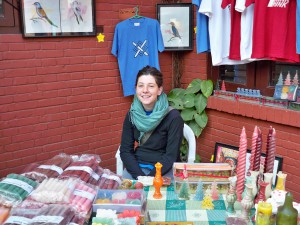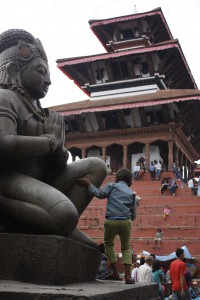
Danielle Preiss, 2008-2009, Nepal, manning a table at a rehab center flea market, during her Fulbright U.S. Student grant
The first thing I remember about preparing to travel to Nepal on a Fulbright U.S. Student grant to study Kathmandu’s drug rehabilitation system was the Nepal Fulbright Commission’s manual. The inch thick book devoted about half of its space to earthquake preparedness. This seemed excessive. I know now of course that it wasn’t.
I began my Fulbright grant in the fall of 2008. According to the manual, Nepal’s earthquake cycle lasts about 75 years, with the last massive quake in 1934. That put my year smack in the middle of when the big one should come. I also now know how agonizingly imprecise earthquake science can be.
Since 2009, I’ve returned to Nepal often. Once you’ve lived in and loved Nepal, the habit is hard to quit. The threat of a massive earthquake hitting was always in the back of my mind, like it undoubtedly was for most Nepalis. I’d walk through Kathmandu’s gorgeous brick alleys in the shadow of concrete high rises wondering which would hold up better (surprisingly it was the high rises), and peer out from viewpoints over the city already heartbroken for the day when buildings would crumble with lives inside.
On April 25, and then cruelly again on May 12, it happened. I mourned the loss of both life and monuments as photos trickled in. Kathmandu’s palatial square, where I’d spent much of my grant chatting with recovering drug users, was nearly gone. The temple where we’d always sit, facing the statue of the god Garuda, was nonexistent. Garuda now stared at just empty steps where our legs used to dangle over endless cups of sweet tea.
Soon after the quake, an amazing force came to life: the spirit of Nepalis and Nepal-lovers around the world came together to start healing the wounded nation. Alongside major INGO and state actors, incredible grass-roots relief groups emerged on the ground, aided in communications and fundraising from Nepalis and supporters abroad.
I spent the weeks after the quake chatting on Facebook with the friends I’d made during my grant and after. We shared news of loved ones found safe, shared resources with contacts on the ground (including other former Fulbrighters), planned fundraisers and debated the merits of going to assist, ultimately deciding to wait until our presence would be more help than hindrance.
Now that the emergency crews have left and the spotlight faded, those who can’t quit Nepal are returning. With the experience I gained from my time with Fulbright, I was asked to help a local non-profit program, Her Turn, in their efforts to empower Nepali girls to be healthy, educated and equal. In the aftermath of a natural disaster, while critical needs like food, water, and shelter are addressed, equally important concerns like sexual safety and menstrual hygiene can fall to the wayside. Her Turn has been delivering basic menstrual hygiene kits to girls and women from earthquake-affected districts, for many of whom privacy is a distant memory and hygiene a struggle.
The damage done by the spring quakes is far from over. The monsoon and landslides now add further destruction to mountain communities who have already lost so much. I’ll never forget the kindnesses extended to me in those villages and the relationships that formed across wide differences of language and culture. Of course, Fulbright is all about bridging those distances. I’m grateful for the time I was allowed to really learn about Nepal and build those relationships that allow me to join its recovery process now.
To learn more about the Her Kit campaign to bring menstrual hygiene kits to earthquake-affected women and girls, visit Her Turn’s website here.



No Comments